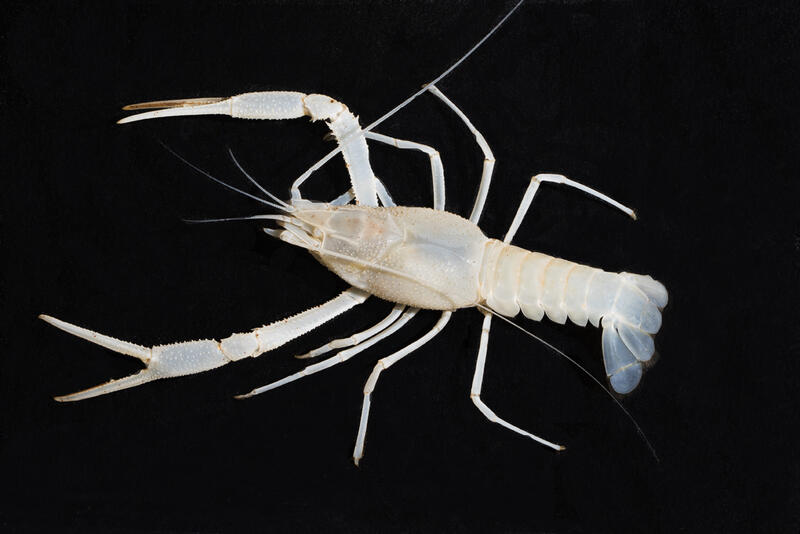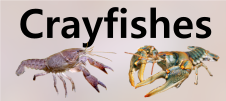







Loading profile. Please wait . . .
Procambarus pallidus (Hobbs, 1940)
Pallid Cave Crayfish




Federal Protection: No US federal protection
State Protection: No Georgia state protection
Global Rank: G1G2
State Rank: S1
Element Locations Tracked in Biotics: Yes
SWAP 2015 Species of Greatest Conservation Need (SGCN): No
SWAP 2025 Species of Greatest Conservation Need (SGCN): Yes
2025 SGCN Priority Tier: High Conservation Concern
Element Occurrences (EOs) in Georgia: 2
Habitat Summary for element in Georgia: Subterraean springs and streams
This is one of two albino crayfish species known to occur in Georgia. Eyes are present but not pigmented and the claws and legs are slender and appear fragile. The rostrum has marginal spines and the areola is narrow. This species reaches a maximum total body length of about 53 mm (2.1 in).
The only species that could be confused with Procambarus pallidus is the Dougherty Plain Cave Crayfish (Cambarus cryptodytes). Cambarus cryptodytes differs from P. pallidus by lacking marginal spines on the rostrum and having a much wider areola. In addition, C. cryptodytes is currently known only from the Apalachicola River drainage while P. pallidus has only been found at two sites in Brooks County located within the Suwannee River drainage.
This species is known only from subterranean habitats. It has been seen and collected in underwater caves.
No studies of the Pallid Cave Crayfish are known. Crayfishes are considered opportunistic omnivores and likely feed on live and decaying vegetation, aquatic insect larvae, small fishes, and dead animal matter.
Because this crayfish is a stygobite (an animal that lives in subterranean aquatic environments), very little is known of its life history. Males in reproductive condition have been collected in all months except January, August, September, and November. Based on this distribution of dates, there is every reason to believe that reproductive males area present all year. One female with eggs was found in December. Some cave species are hypothesized to live more than two decades.
Purvis and Opsahl (2005) were able to catch several individuals of Cambarus cryptodytes in study wells with a modified funnel trap. Fenolio et al. (2017) used a trap designed by Gluesenkamp and Krejca (2007) to collect this species from wells. If there are wells present within the range of P. pallidus, it would likely be susceptible to this type of trapping as well. SCUBA diving in subterranean habitats could yield the species.
Hobbs (1989) reported Pallid Cave Crayfish from subterranean habitats in the Suwannee River system in Suwannee County, FL, south to Alachua and Levy counties. It was recently discovered in Georgia in the Withlacoochee River system (Suwannee tributary) in Brooks County.
Small range size makes this species vulnerable to extirpation from the state. Excessive water withdrawals from the Floridian Aquifer could reduce the amount of habitat for the Pallid Cave Crayfish. Runoff of pesticides and nutrients from agricultural areas is also a threat.
| Threat 1 | Threat 2 | Threat 3 | |
|---|---|---|---|
| General Threat | Human intrusions & disturbance | Pollution | None |
| Specific Threat | None | None | None |
Since this species is currently known only from two locations in Georgia, it is vulnerable to extirpation from the state.
Restrict access to sensitive cave habitats. Use vegetated buffers around groundwater recharge areas and streams to protect water quality within caves. Identify levels of groundwater withdrawal that are compatible with aquatic habitat needs for crayfishes and other stygobites. Educate the public on the importance of groundwater resources and the sensitive nature of the fauna that relies on subterranean aquatic habitats. Conduct additional survey work to better define the species range in Georgia.
Fenolio, D.B., M.L. Niemiller, A.G. Gluesenkamp, A.M. McKee, and S.J. Taylor. 2017. New distributional records of the stygobitic crayfish Cambarus cryptodytes (Decapoda: Cambaridae) in the Floridan aquifer system of southwestern Georgia. Southeastern Naturalist 16:163–181.
Gluesenkamp, A.G., and J.K. Krejca. 2007. Assessing the status of Eurycea salamanders and aquifer invertebrates in northern Hays County, Texas. Report prepared for Texas Parks and Wildlife Department, Austin, TX. 15 pp.
Hobbs, H.H., Jr. 1981. The crayfishes of Georgia. Smithsonian Contributions to Zoology 318:1–549.
Hobbs, H.H., Jr. 1989. An illustrated checklist of the American crayfishes (Decapoda: Astacidae, Cambaridae, and Parastacidae). Smithsonian Contributions to Zoology 480:1–236.
Purvis, K.M., and S. Opsahl. 2005. A novel technique for invertebrate trapping in groundwater wells identifies new populations of the troglobitic crayfish, Cambarus cryptodytes, in southwest Georgia, USA. Journal of Freshwater Ecology 20:361–365.
Taylor, C.A., G.A. Schuster, J.E. Cooper, R.J. DiStefano, A.G. Eversole, P. Hamr, H.H. Hobbs III, H.W. Robison, C.E. Skelton, and R.F. Thoma. 2007. A reassessment of the conservation status of crayfishes of the United States and Canada after 10+ years of increased awareness. Fisheries 32:372–389.
Christopher E. Skelton
C. Skelton, March 2019: original account
D.Weiler, October 2019: photo added